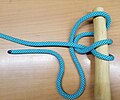| Tugboat hitch | |
|---|---|
 | |
| Names | Tugboat hitch,
|
| Category | Hitch |
| Releasing | Non-jamming, releasable under load |
| Typical use |
|
| ABoK | #1795 |
The Tugboat hitch, also called a Backhanded mooring hitch or Lighterman's Hitch, is a knot ideal for heavy towing, or securing a craft to a post, bollard, or winch. It is easy to release, even under great load.





